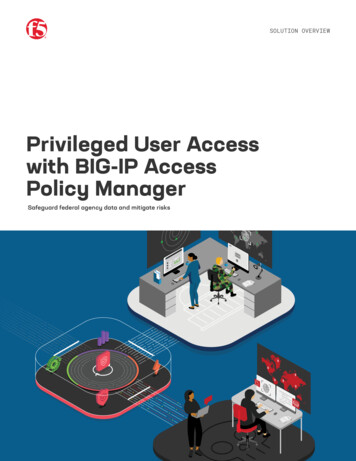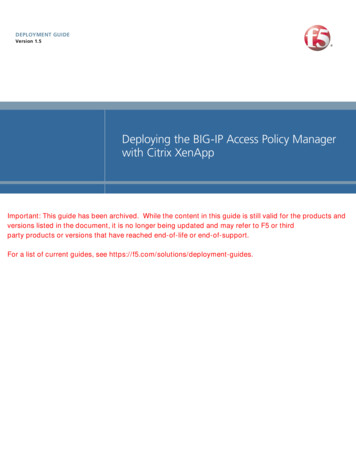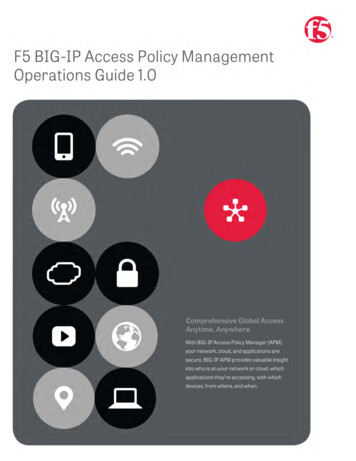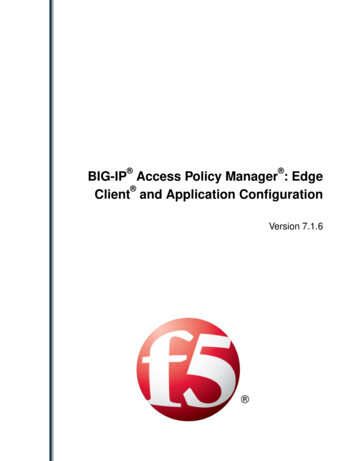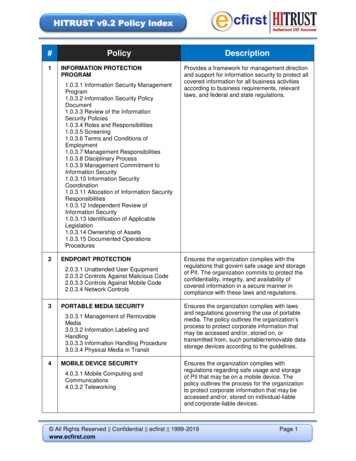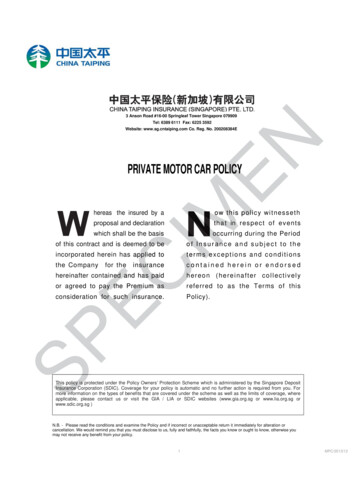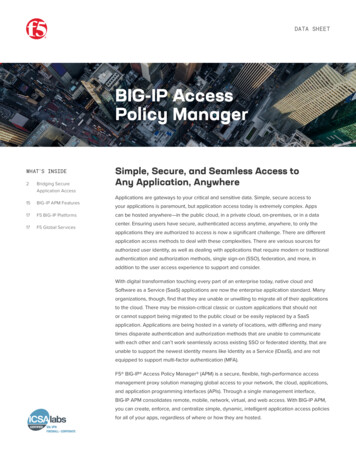
Transcription
DATA SHEETBIG-IP AccessPolicy ManagerWHAT'S INSIDE2 Bridging SecureApplication Access15 BIG-IP APM Features17 F5 BIG-IP Platforms17 F5 Global ServicesSimple, Secure, and Seamless Access toAny Application, AnywhereApplications are gateways to your critical and sensitive data. Simple, secure access toyour applications is paramount, but application access today is extremely complex. Appscan be hosted anywhere—in the public cloud, in a private cloud, on-premises, or in a datacenter. Ensuring users have secure, authenticated access anytime, anywhere, to only theapplications they are authorized to access is now a significant challenge. There are differentapplication access methods to deal with these complexities. There are various sources forauthorized user identity, as well as dealing with applications that require modern or traditionalauthentication and authorization methods, single sign-on (SSO), federation, and more, inaddition to the user access experience to support and consider.With digital transformation touching every part of an enterprise today, native cloud andSoftware as a Service (SaaS) applications are now the enterprise application standard. Manyorganizations, though, find that they are unable or unwilling to migrate all of their applicationsto the cloud. There may be mission-critical classic or custom applications that should notor cannot support being migrated to the public cloud or be easily replaced by a SaaSapplication. Applications are being hosted in a variety of locations, with differing and manytimes disparate authentication and authorization methods that are unable to communicatewith each other and can’t work seamlessly across existing SSO or federated identity, that areunable to support the newest identity means like Identity as a Service (IDaaS), and are notequipped to support multi-factor authentication (MFA).F5 BIG-IP Access Policy Manager (APM) is a secure, flexible, high-performance accessmanagement proxy solution managing global access to your network, the cloud, applications,and application programming interfaces (APIs). Through a single management interface,BIG-IP APM consolidates remote, mobile, network, virtual, and web access. With BIG-IP APM,you can create, enforce, and centralize simple, dynamic, intelligent application access policiesfor all of your apps, regardless of where or how they are hosted.
KEY BENEFITSSimplify access to all appsBridge secure access to onpremises and cloud apps with asingle login via SSO. It even worksfor applications unable to supportmodern authentication suchas Security Assertion MarkupLanguage (SAML), or OAuth andOpenID Connect (OIDC).Zero Trust application accessIdentity Aware Proxy (IAP) deliversa Zero Trust model validationfor application access based onidentity-awareness and granularcontext, securing every appaccess request without the needof a VPN.Secure web accessControl access to web-basedapplications and web contentcentralizing authentication,authorization, and endpointinspection via web app proxy.Centralize and manage accesscontrolConsolidate management ofremote, mobile, network, virtual,and web access in a single controlinterface with adaptive identityfederation, SSO, and MFA viadynamically enforced, contextbased and identity-aware policies.Streamlined authentication andauthorizationAdaptive identity federation,SSO, and MFA employing SAML,OAuth, and OIDC for a seamlessand secure user experienceacross all apps.B R I D G I N G S E C U R E A P P L I C AT I O N A C C E S SModern authentication and authorization protocols—including Secure Assertion MarkupLanguage (SAML), and OAuth with OpenID Connect (OIDC)—reduce user dependency onpasswords, increase security, and improve user experience and productivity. However, not allapplications support modern authentication and authorization protocols. Many applications,such as classic applications or custom-built applications, support classic authenticationand authorization methods, such as Kerberos, NT LAN Manager (NTLM), RADIUS, headerbased, and more. This further complicates application access and security. The need tosupport different, disparate protocols unable to share user authentication and authorizationinformation inhibits the use of SSO and MFA. That in turn negatively impacts user experienceand application security. It also makes it difficult to adapt modern corporate passwordpolicy of periodic password changes, and increases organizational costs as multiple accessmethods become necessary.BIG-IP APM serves as a bridge between modern and classic authentication and authorizationprotocols and methods. For applications which are unable to support modern authenticationand authorization protocols, like SAML and OAuth with OIDC, but which do supportclassic authentication methods, BIG-IP APM converts user credentials to the appropriateauthentication standard supported by the application. BIG-IP APM ensures that users ororganizations can use SSO to access any application anywhere—regardless of its location(on-premises, in a data center, in a private cloud, or in the public cloud as a native cloudor SaaS application), or whether or not it supports modern or classic authentication andauthorization. This helps decrease the number of passwords users have to create, remember,and use, helping to stem the tide of credential-based attacks. It enables compliance withmodern corporate policies of periodic password changes to combat stolen credentials. Italso decreases the cost to organizations of having to purchase and maintain separate accesssolutions for applications hosted on-premises, in a data center, and in a private cloud, versusnative cloud and SaaS apps.BIG-IP APM supports identity federation and SSO options by supporting connections initiatedby both SAML identity providers (IdP) and service providers (SP) leveraging SAML 2.0. Itempowers administrators to centrally enable and disable user authorized access to anyidentity-enabled applications, regardless of where they are hosted, saving time and boostingadministrative productivity.Support for OAuth 2.0 open-standard for authorization enables BIG-IP APM to serve as aclient, as an authorization delegate for SaaS applications, and can enhance protection for andauthorization of APIs for web services.DATA SHEET BIG-IP ACCESS POLICY MANAGER2
KEY BENEFITS (CONT.)Defend your weakest linksProtect against data loss,malware, and rogue deviceaccess with comprehensive,continuous endpoint integrity andsecurity checks.Protect APIsEnable secure authenticationfor REST and SOAP APIs andintegrate OpenAPI or “swagger”files to ensure appropriateauthentication actions whilesaving time and cost.Do it all at scaleSupport all users easily, quickly,and cost-effectively with noperformance trade-offs forsecurity, even in the mostdemanding environments.SUPPORT FOR IDaaSWith support for SSO and Kerberos ticketing across multiple domains, BIG-IP APM enablesadditional types of authentication, such as U.S. Federal Government Common Access Cards(CAC) and the use of IDaaS—such as Microsoft Azure Active Directory, Okta, and others—to access all applications regardless of location or modern authentication and authorizationsupport. For instance, users can be automatically signed on to back-end applications andservices that are part of a Kerberos realm. This provides a seamless authentication flowonce a user has been authenticated through a supported user-authentication mechanism.BIG-IP APM also supports smart cards with credential providers, so users can connect theirdevices to their network before signing in.S U P P O R T F O R M FAThrough F5’s extensive partner ecosystem, BIG-IP APM also integrates with most leading MFAsolutions, including those from Cisco Duo, Okta, Microsoft Azure Active Directory, and others.By integrating with your existing MFA solution, BIG-IP APM enables adaptive authentication,allowing various forms of single-, two-, or multi-factor authentication to be employed based onuser identity, context, and application access. In addition, to help you deploy MFA, BIG-IP APMincludes one-time password (OTP) authentication via email or SMS.After the user has logged into an application, an additional means of authentication may berequired to ensure secure access to mission-critical or particularly sensitive applications andfiles. This is commonly referred to as step-up authentication. BIG-IP APM supports step-upauthentication for single- and multi-factor authentication. Any session variable may be usedto trigger step-up authentication, and you can use additional authentication capabilities orselect from our partner offerings. In addition, any session variable may be part of accesspolicy branching (such as URL branching) per request policy. Step-up authentication policiesmay be based on applications, secure portions of applications, sensitive web URIs, extendingsessions, or any session variable.Many authentication solutions use application coding, separate web server agents, orspecialized proxies that present significant management, cost, and scalability issues. WithAAA control, BIG-IP APM enables you to apply customized access policies across manyapplications and gain centralized visibility of your authorization environment. You canconsolidate your AAA infrastructure, eliminate redundant tiers, and simplify management toreduce capital and operating expenses.DATA SHEET BIG-IP ACCESS POLICY MANAGER3
Z E R O T R U S T A P P L I C AT I O N A C C E S SMany organizations—possibly including yours—are rapidly moving toward adoption of aZero Trust security architecture. The pillars of a Zero Trust security architecture are identityand context.A Zero Trust approach to security means adopting a mindset that attackers have alreadyinfiltrated your network and are lurking, waiting for an opportunity to launch an attack. Iteliminates the idea of a trusted insider within a defined network perimeter, assuming, at best,a limited secure network perimeter. It encourages never trusting users, even if they’ve alreadybeen authenticated, authorized, and granted access to applications and resources. A ZeroTrust security approach applies least privilege rights to user access, allowing users to accessonly those applications and resources they are authorized for, and restricting their access to asingle application or resource at a time.Identity- and context-awareness are also what define Identity Aware Proxy (IAP). IAP enablessecure access to specific applications by leveraging a fine-grained approach to userauthentication and authorization. IAP enables only per-request application access, which isvery different than the broad network access approach of VPNs that apply session-basedaccess, which is not a Zero Trust approach. With this approach, VPN becomes optional toaccess applications. IAP enables the creation and enforcement of granular application accesspolicies based on contextual attributes, such as user identity, device integrity, and userlocation. IAP relies on application-level access controls, not network-layer rules. Configuredpolicies reflect user and application intent and context. IAP requires a strong root of trustedidentity to verify users, and to stringently enforce what they are authorized to access.Identity Aware Proxy is key to both a Zero Trust security architecture and to F5 BIG-IP APM.BIG-IP APM and F5 Access Guard deliver Identity Aware Proxy using a Zero Trust validationmodel on every application access request. Providing authenticated and authorized userssecure access to specific applications, it leverages F5 best-in-class access proxy. BIG-IP APMcentralizes user identity and authorization. Authorization is based on the principles of leastprivileged access.DATA SHEET BIG-IP ACCESS POLICY MANAGER4
Through IAP, BIG-IP APM examines, terminates, or authorizes application access requests.Policies within BIG-IP APM can be created to: Verify user identity Check device type and posture Validate user authorization Confirm application integrity and sensitivity Confirm time and date accessibility Limit or halt access if the user’s location or their device posture is deemed incorrect,inappropriate, or insecure Request additional forms of authentication—including multi-factor authentication (MFA)—if the user’s location or the sensitive nature of the applications or its data warrant it And moreData from user and entity behavior analytics (UEBA) and other API-driven risk engines can beintegrated seamlessly adding another level of security and application access control.BIG-IP APM checks user device security posture via F5 Access Guard, a browser extension thatcoordinates with BIG-IP APM. However, BIG-IP APM and F5 Access Guard go beyond simplychecking device integrity at authentication to deliver continuous, ongoing device posturechecks, ensuring that user devices not only meet but adhere to endpoint security policiesthroughout application access. If BIG-IP APM detects any change in device integrity, it can eitherlimit or stop application access, halting potential attacks before they can even be launched.A guided configuration workflow allows organizations to host web applications protected byIdentity Aware Proxy on a webtop, providing users a single catalog of their applications. Itoffers a seamless user experience, as users can access applications, regardless of where theyare hosted. It also simplifies the administrative workflow, enabling administrators to easilypick, choose, and modify the applications accessible by a specific user group.BIG-IP APM, through IAP, also simplifies application access for remote or home-based workersand better enables and secures application accessibility, and optionally eliminates the needfor VPNs.ROBUST ENDPOINT SECURITYBIG-IP APM inspects and assesses users’ endpoint devices before authentication andthroughout the user’s application access with F5 Access Guard. F5 Access Guard examinesdevice security posture and determines if the device is part of the corporate domain. Basedon the results, BIG-IP APM will apply dynamic access control lists (ACLs) to deploy contextbased security. BIG-IP APM and F5 Access Guard include preconfigured, integrated endpointDATA SHEET BIG-IP ACCESS POLICY MANAGER5
inspection checks, including checks for OS type, antivirus software, firewall, file, process,registry value validation and comparison (Windows only), as well as device MAC address, CPUID, and HDD ID. For mobile devices running iOS or Android, BIG-IP APM’s endpoint inspectionchecks the mobile device UDID and jailbroken or rooted status.R I S K - BA S E D AC C E S S U S I N G T H I R D - PA R T Y R I S K E N G I N E S(HTTP CONNECTOR)Many organizations have deployed third-party user and entity behavior analytics (UEBA)or risk engines. The ability to leverage an existing UEBA or risk engine to infuse real-timeanalytics and risk data within their access control policies can help those organizationsensure that access to networks, clouds, applications, and even APIs, are regulated based ona risk profile. It is also important to address risk-based access to networks, clouds, apps, andAPIs that is triggered by a variety of relevant variables.Through its HTTP Connector, BIG-IP APM integrates with third-party UEBA and risk engines,leveraging their risk assessment via REST APIs as part of its policy-based access controls.This enables risk-based access to networks, clouds, apps, and APIs, further enhancing BIG-IPAPM’s Zero Trust IAP solution. BIG-IP APM’s HTTP Connector leverages user group, domain,and network-based triggers to increase the enforceability of risk-based access. Risk-basedaccess enhances security, providing greater visibility and analytics to determine whether togrant or deny access to your networks, cloud, applications, and APIs.I N T E L L I G E N T I N T E G R AT I O N W I T H I D E N T I T Y A N D A C C E S SMANAGEMENT (IAM)F5 partners with leading on-premises and cloud-based identity and access management (IAM)vendors, such as Microsoft, Okta, and Ping Identity. This integration enables local and remoteuser SSO via SAML, OAuth or FIDO2 (U2F) to applications based on premises or in a datacenter. For organizations that do not wish to replicate their user credential store in the cloudwith IDaaS or cloud-based IAM offerings, working with its partners, F5 and BIG-IP APM work tohelp these organizations maintain control of on-premises user credentials. This is accomplishedby creating a bridge between the IAM vendor’s offering and the local authentication services.This bridge, or identity provider chain, leverages SAML to federate user identity.UNIFYING ACCESS FROM ANY DEVICEBIG-IP APM is positioned between your applications and your users, providing a strategicapplication access control point. It protects your public-facing applications by providinggranular policy for identity- and context-aware user access, while consolidating your accessinfrastructure. It secures remote and mobile access to applications, networks, and cloudsDATA SHEET BIG-IP ACCESS POLICY MANAGER6
via SSL VPN or Zero Trust application access. BIG-IP APM converges and consolidates allaccess—network, cloud, application, and API—within a single management interface. It alsoenables and simplifies the creation of easy to manage dynamic access policies.BIG-IP APM includes a dynamic web-based application portal or webtop. The BIG-IP APMwebtop shows only the applications authorized for and available to a user based on theiridentity and context—regardless of where the applications are hosted—on-premises, in a datacenter, in a private cloud, in a public cloud, or offered as a service.BIG-IP APM enables Datagram Transport Layer Security (DTLS) mode, supporting DTLS 2.0for remote connections that secure and tunnel delay-sensitive applications. It supports IPsecencryption for traffic between branch offices or data centers. Per-app VPN via an applicationtunnel through BIG-IP APM enables access to a specific application without the security risk ofopening a full network access tunnel.F5 BIG-APM enables secure access to applications, networks, and clouds via the BIG-IPEdge Client and F5 Access. The BIG-IP Edge Client is available for Apple MacOS, MicrosoftWindows, Linux platforms, and Chromebooks. F5 Access is an optional mobile client forensuring secure access from mobile devices supporting Apple iOS and Google Android, andis available for download from the Apple App Store or Google Play.BIG-IP Edge Client and F5 Access integrate with leading mobile device management (MDM)and enterprise mobility management (EMM) solutions—including VMware Horizon ONE(AirWatch), Microsoft Intune, and IBM MaaS360—to perform device security and integritychecks and to deliver per-app VPN access without user intervention. Context-aware policiesare assigned based on a device’s security state. These policies enable, modify, or disableapplication, network, and cloud access from the device. Hardware attributes may be mappedto a user’s role to enable additional access control decision points. A browser cache cleanerautomatically removes any sensitive data at the end of a user’s session.Biometrics, such as fingerprint access, are supported to open and access the F5 Edge Client.This simplifies access, since a user will no longer need to create, remember, and input ausername/password credential to access the Edge Client. It also makes accessing the EdgeClient more secure, as users reuse passwords or create simple username/password pairs,making them easier for attackers to hack.BIG-IP APM also supports server authentication via Client Certificate Constrained Delegation(C3D). By employing C3D, BIG-IP APM addresses certificate-based authentication, limiting theneed for and use of credentials. With C3D, organizations can implement stronger encryptionprotocols and the latest key exchanges, as well as employ client certificate authentication,enable end-to-end encryption in reverse proxy environments, leve
DATA SHEET BII ACCESS OICY ANAE 3 SUPPORT FOR IDaa S With support for SSO and Kerberos ticketing across multiple domains, BIG-IP APM enables additional types of authentica
